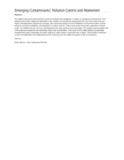| dc.contributor.author | Ng'eno, Emily | |
| dc.contributor.author | Shikuku, Victor Odhiambo | |
| dc.date.accessioned | 2021-12-31T08:16:40Z | |
| dc.date.available | 2021-12-31T08:16:40Z | |
| dc.date.issued | 2020-09 | |
| dc.identifier.uri | https://doi.org/10.4018/978-1-7998-1871-7.ch010 | |
| dc.identifier.uri | https://www.igi-global.com/chapter/emerging-contaminants/248381 | |
| dc.identifier.uri | http://ir-library.mmust.ac.ke:8080/xmlui/handle/123456789/1929 | |
| dc.description.abstract | his chapter discusses water pollution control and abatement strategies in relation to emerging contaminants. The pollution prevention measures described in the chapter can broadly be categorized into four main areas that are highly interdependent: behavioral changes, new technical solutions to aid remediation of the environment, further research and data availability, and legislation or policy reforms. These main areas have been expanded in detail under 13 subtitles that are not only interdependent but also practical and achievable. The chapter demonstrates that if the proposed measures are collectively taken into consideration, then most of the United Nations Sustainable Development goals, especially the goals relating to water quality, would become a reality. The benefits of pollution control and abatement are widespread and far-reaching and can better the quality of life on the planet. | en_US |
| dc.language.iso | en | en_US |
| dc.publisher | IGI Global | en_US |
| dc.subject | Emerging, Contaminants, Pollution, Control, Abatement | en_US |
| dc.title | Emerging Contaminants: Pollution Control and Abatement | en_US |
| dc.type | Article | en_US |

